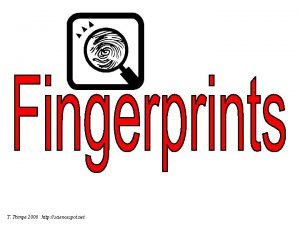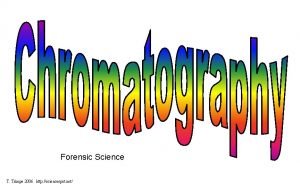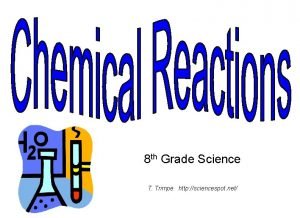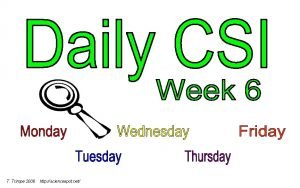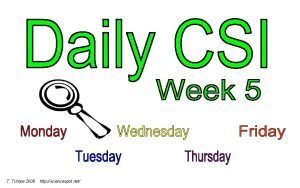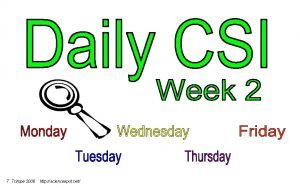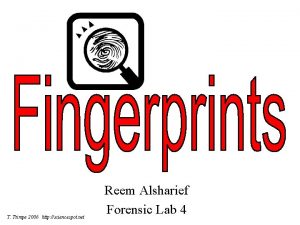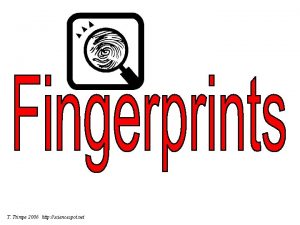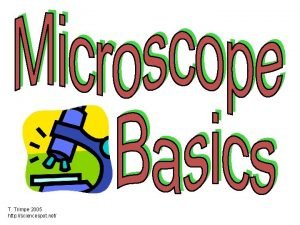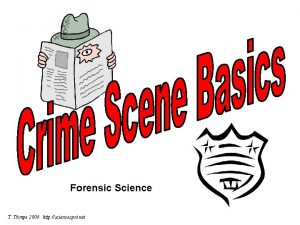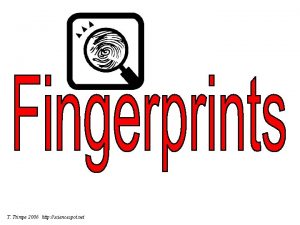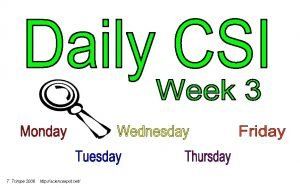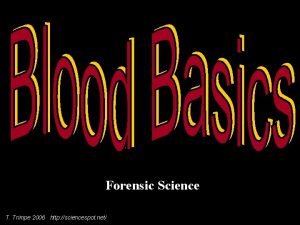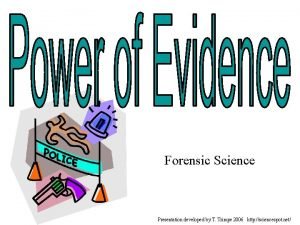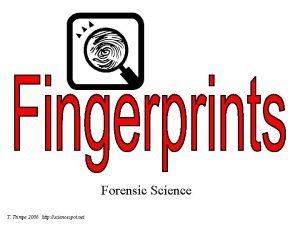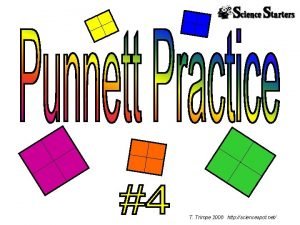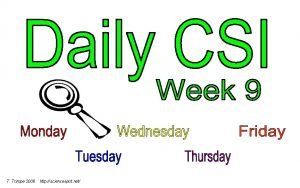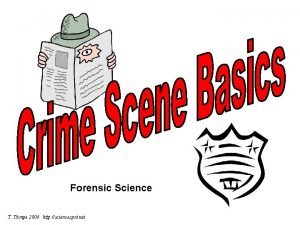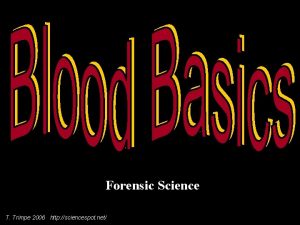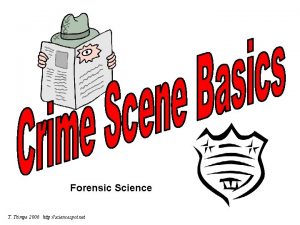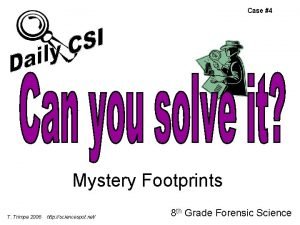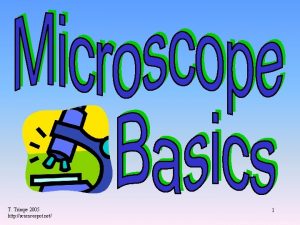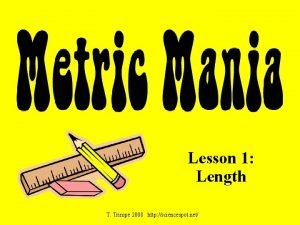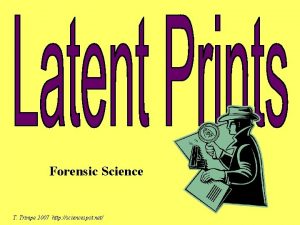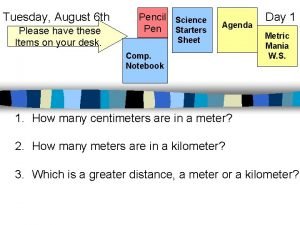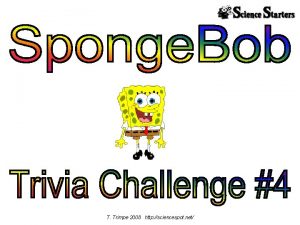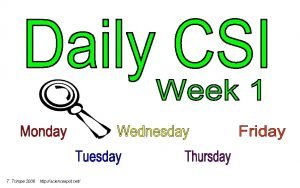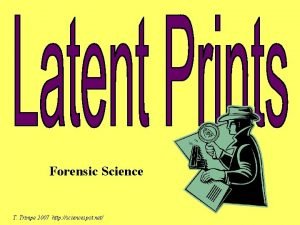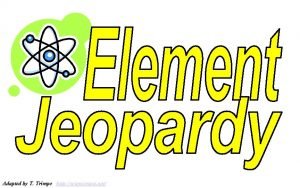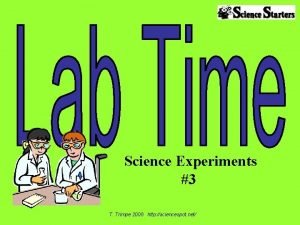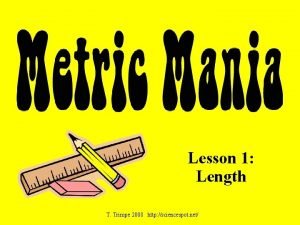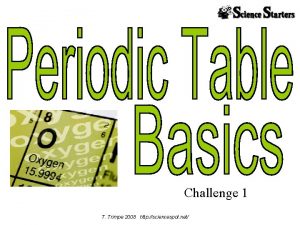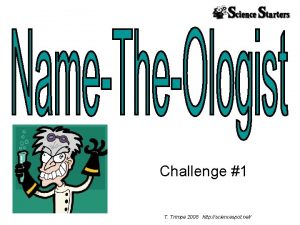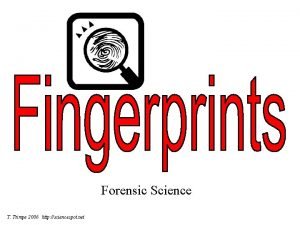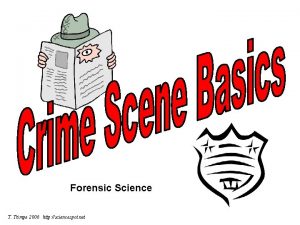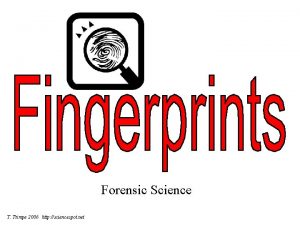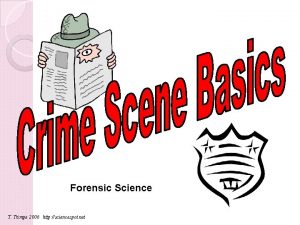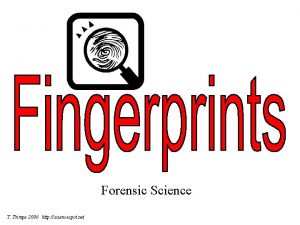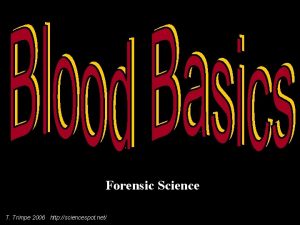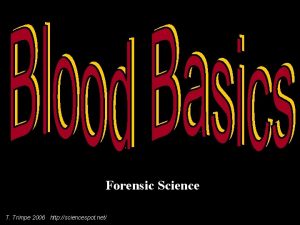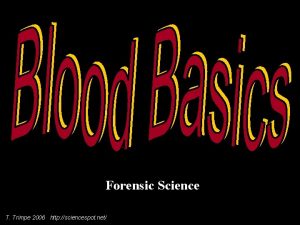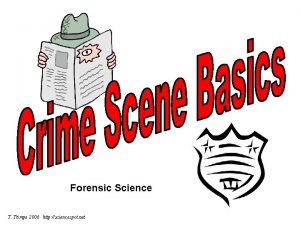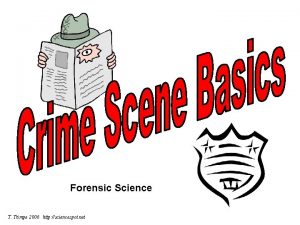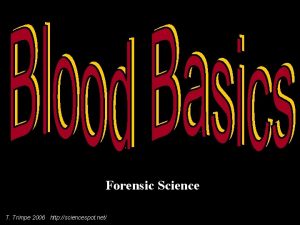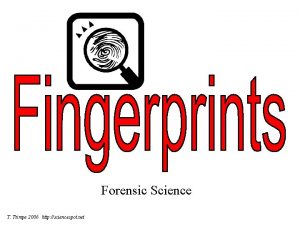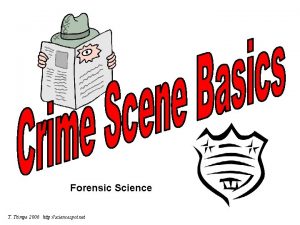Forensic Science T Trimpe 2006 http sciencespot net




































- Slides: 36

Forensic Science T. Trimpe 2006 http: //sciencespot. net

Crime Scene Vocabulary CRIME SCENE: Any physical location in which a crime has occurred or is suspected of having occurred. PRIMARY CRIME SCENE: The original location of a crime or accident. SECONDARY CRIME SCENE: An alternate location where additional evidence may be found. SUSPECT: Person thought to be capable of committing a crime. ACCOMPLICE: Person associated with someone suspected of committing a crime. ALIBI: Statement of where a suspect was at the time of a crime. Source: http: //www 3. sc. maricopa. edu/ajs/crime_scene_technician. htm

Types of Evidence Testimonial evidence includes oral or written statements given to police as well as court testimony by people who witnessed an event. Physical evidence refers to any material items that would be present at the crime scene, on the victims, or found in a suspect’s possession. Trace evidence refers to physical evidence that is found in small but measurable amounts, such as strands of hair, fibers, or skin cells. What will evidence collected at a scene do for the investigation? • May prove that a crime has been committed • Establish key elements of a crime • Link a suspect with a crime scene or a victim • Establish the identity of a victim or suspect • Corroborate verbal witness testimony • Exonerate the innocent. • Give detectives leads to work with in the case Source: http: //www 3. sc. maricopa. edu/ajs/crime_scene_technician. htm

Crime Scene Personnel POLICE OFFICERS are typically the first to arrive at a crime scene. They are responsible for securing the scene so no evidence is destroyed and detaining persons of interest in the crime. The FORENSICS UNIT documents the crime scene in detail and collects any physical evidence. The CROWN ATTORNEY is often present to help determine if any search warrants are required to proceed and obtains those warrants from a judge. The MEDICAL EXAMINER (if a homicide) may or may not be present to determine a preliminary cause of death. SPECIALISTS (forensic entomologists, anthropologists, or psychologists) may be called in if the evidence requires expert analysis. DETECTIVES interview witnesses and consult with the Forensics unit. They investigate the crime by following leads provided by witnesses and physical evidence. Source: http: //science. howstuffworks. com/csi. htm

Crime Scene Protocol Step 1: Interview The first step in investigating a crime scene is to interview the first officer at the scene or the victim to determine what allegedly happened, what crime took place, and how was the crime committed. This information may not be factual information but it will give the investigators a place to start. Step 2: Examine The second step in the investigation of a crime scene, which will help identify possible evidence, identify the point of entry and point of exit, and outline the general layout of the crime scene. Step 3: Document The third step in the protocol involves creating a pictorial record of the scene as well as a rough sketch to demonstrate the layout of the crime scene and to identify the exact position of the deceased victim or other evidence within the crime scene. Step 4: Process This is the last step in the protocol. The crime scene technician will process the crime scene for evidence, both physical and testimonial evidence. It is the crime scene technicians responsibility to identify, evaluate and collect physical evidence from the crime scene for further analysis by a crime laboratory. Adapted from http: //www. feinc. net/cs-proc. htm

Investigating the Evidence Drug Chemistry – Determines the presence of controlled substances and the identification of marijuana Trace Chemistry - Identification and comparison of materials from fires, explosions, paints, and glass. Microscopy – Microscopic identification and comparison of evidence, such as hairs, fibers, woods, soils, building materials, insulation and other materials. Biology/DNA – Analysis of body fluids and dried stains such as blood, semen, and saliva. Toxicology – Tests body fluids and tissues to determine the presence of drugs and poisons. Latent Prints - Identification and comparison of fingerprints or other hidden impressions from sources like feet, shoes, ears, lips or the tread on vehicle tires. Ballistics (Firearms) – Study of bullets and ammunition through the comparison of fired bullets, cartridges, guns, and gunpowder patterns on people and objects. Toolmarks – Examines marks left by tools on objects at a crime scene or on a victim, such as a hammer used to break a door or a screwdriver used to pick a lock. Questioned Documents - Examination of documents to compare handwriting, ink, paper, writing instruments, printers, and other characteristics that would help to identify its origin. Source: http: //www. isp. state. il. us/forensics/

What evidence would you collect? Mock Crime Scene:

Let the evidence speak for itself. Presentation developed by T. Trimpe 2006 http: //sciencespot. net/

Locard’s Exchange Principle "Every Contact Leaves a Trace" The value of trace (or contact) forensic evidence was first recognized by Edmund Locard in 1910. He was the director of the very first crime laboratory in existence, located in Lyon, France. The Locard’s Exchange Principle states that "with contact between two items, there will be an exchange. " For example, burglars will leave traces of their presence behind and will also take traces with them. They may leave hairs from their body or fibers from their clothing behind and they may take carpet fibers away with them. Source: http: //www. virtualsciencefair. org/2004/fren 4 j 0/public_html/trace_evidence. htm

Evidence Examples Tiny Pieces of Evidence Paint • Physical and chemical analysis of paint evidence (chips or residue) can indicate it’s class, such as automobile paint, house paint, nail polish, etc. The evidence can be compared to 40, 000 different types of paint classified in a database, which can be used to identify a particular make or model of car or brand of tool. • Paint evidence can also indicate individual characteristics if an investigator is able to find similarities between two samples, such as the color, number of layers, chemical composition, or a physical match between the edges of two paint chips – one from a tool and one from a crime scene. Paint Transfer on a Car Did you know? Most paint evidence submitted to a lab will come from hit-and-run cases involving automobiles. Paint Layers Physical Match of Paint Chip Edges Images: http: //www. state. nj. us/njsp/divorg/invest/criminalistics. html

Glass • Glass particles can be found at various crime scenes, such as breaking and entering, hit and run, vandalism, or murder. • Glass at a crime scene is analyzed to determine its color, surface characteristics, tint, thickness, density, chemical composition, and refractive index (RI). • The results of the tests provide clues about the crime and help investigators connect the evidence to a suspect or other object used in a crime, such as matching glass from a crime scene to a headlight to a suspect’s car. CSI Glass Analysis Magnified image of glass fragments The pattern of cracks in a windshield fracture can reveal information about speed, occupant position, and angle of impact. Images: http: //www. rsc. org/images/b 606109 e-300 -(FOR-TRIDION)%20(i. Stockphotos)_tcm 18 -68354. jpg, http: //www. mtcforensics. com/investigation. html

Explosives • Explosive substances can be examined to determine its chemical composition to identify the type of explosive used and its origin. • Traces of explosives found on a suspect’s clothing, skin, hair, or other objects may be matched to explosives from the crime scene. • Materials used to make an explosive device will be compared to evidence found in the suspect’s possession to confirm a match. CSI & Explosives Image: http: //www. state. nj. us/njsp/divorg/invest/criminalistics. html

Ballistics • Characteristics of ammunition, firearms, and residue are examined to find matches between suspects and the evidence found at a crime scene. • Chemical tests can reveal gunshot residue (GSR) on the hands, face, or clothing of a victim or suspect to indicate how close a person was to a fired gun. • Rifling (grooves) in a gun barrel causes distinctive grooves, indentations and scratches upon fired bullets, which can be matched to the weapon that fired them. • Police are able to search the Integrated Ballistics Identification System (IBIS) database to compare markings from bullets, cartridge cases, and shotgun shells to ballistic evidence. Did you know? Caliber (handguns & rifles) or gauge (shotguns) refers to the size of the internal diameter of a gun’s barrel. Investigators can compare the striations on bullets to see if they match. Learn more about ballistics … Image: http: //www. geocities. com/j_ksinha/img/mid 1. gif

Dust & Dirt • Dust, dirt, or sand evidence can reveal where a person has traveled and may be picked up at a crime scene or left behind. Microscopic Image of Sand • Investigators examine the samples for chemical composition, pollen, plant material, and other organic matter to find links to a specific crime scene. Fingerprints • There are 3 types of fingerprint patterns: arches, loops, and whorls. Investigators also identify unique ridge characteristics in a fingerprint that can be used to identify a suspect or victim. • AFIS (Automated Fingerprint Identification System) is a database used by investigators at local, state, and national levels to search for matches to fingerprints found at a crime scene. Images: http: //www. npsg. uwaterloo. ca/resources/images/microscope/Sand%200004. jpg

Impression Evidence Shoeprints & Tire Tracks • Impression evidence can be photographed, lifted with tape, or cast with plaster to compare to a suspect’s shoes or tires. • Investigators will examine the evidence to identify the brand of shoe or tire based on its tread pattern and other physical features to provide leads in the case. • Shoes and tires will also show wear patterns after being used for a period of time as well as other features (scratches, nicks, and cuts) that can be used to match evidence to specific items. For example, shoeprints can be matched to a suspect based on how the treads on the shoes that are worn down due to that person’s walking style. Bite Marks • Each of the 32 teeth in humans is unique due to age and wear. • Impressions and photographs of bite marks left on a victim, assailant, or other object at a crime scene can often be matched to dental records. Tool Marks • Tiny nicks and chips form on the edges of a tool as it is used, which can be used to identify matches between evidence and suspects. • Tools may also pick up traces of blood or other substances that can be tested or have fingerprints that can be lifted. Images: http: //www. wrongfulconvictionlawsuitdefense. com/uploads/image/28 santos_600. jpg, http: //www. dps. state. ia. us/DCI/Crime_Lab/images/toolmarks. jpg, & http: //www. masterpiecestudios. com/images/171463. gif

Fracture Matches • When an object broken, torn, or cut, two unique edges are formed, which are referred to as fracture lines. • These edges can be compared by the naked eye or with microscopes to see if they fit together , which indicates that they may have been part of the same object at one time. • Investigators may compare the edges on pieces of tape, glass fragments, paint chips, pieces of a car from an accident, paper bag, etc. to find possible matches. Duct Tape Evidence Images: http: //www. modernmicroscopy. com/main. asp? article=11&print=true&pix=true

Wounds • Wounds can often be matched to weapons or tool marks on the weapon. Investigators may also be able to determine the weapon's size, shape, and length. • Analysis of a wound may provides clues to a victim’s injuries, characteristics of the suspect (left-handed, right-handed, height, etc. ), and positions of the victim and suspect at the time of the incident. Questioned Documents • Examiners will analyze a ransom note or other document to find clues to link it to a crime scene or a specific suspect. They will analyze the type of paper used, printing method or handwriting style, and type of ink. FBI Questioned Documents UNIT • Other unique features, such as watermarks on stationary or indentations made as someone wrote on a page in a notebook, may provide useful clues. Image: (Bottom Left): http: //dofs. gbi. georgia. gov/vgn/images/portal/cit_11783501/81672146 questioned%20 document. jpg

Insects • Flies, beetles, and other insects can provide useful clues about a corpse. • Forensic entomologists use factors such as weather conditions, the location and condition of the body, and their knowledge of the life cycles of insects to help them estimate the postmortem interval or PMI (the time between death and the discovery of the body). DNA • Investigators can extract DNA from almost any tissue, including hair, fingernails, bones, teeth and body fluids. The DNA is used to create a profile that can be compared to profiles from suspects or victims. • CODIS (Combined DNA Index System) is a database maintained by the FBI that is used to find matches to unknown DNA samples from a crime scene. Images: http: //biology. arizona. edu/sciconn/lessons 2/Vuturo/vuturo/photos/desmus. gif

Skeletal Remains • Forensic anthropologists analyze skeletal remains to determine four characteristics for a victim: age, sex, race, and stature (height/build). Sex - Determined by examining the pelvis, humerus, and femur Age and stature – Determined by analyzing the development of the teeth, bone growth, and the length of specific bones, such as the femur. Race – Determined by analyzing the skull for characteristics that are common among people of different races. • DNA samples can be collected from bone, teeth, and hair to provide clues to a person’s identity. Scientists may also be able to gain clues as to a person’s past, recent injuries, or the cause of death based on bone fractures and other signs of trauma. Source: http: //www. crime-scene-investigator. net/excavation. html Images: http: //www. celticnz. org/images/Feedback/Skull. Skeleton. JPG and http: //www. legacyhealth. org/images/Housecalls/claviclefx. jpg

What do forensic anthropologists do? Generally, forensic anthropologists DO NOT do any of the following: • Collect trace evidence (hair, fibers) • Run DNA tests • Analyze ballistics or weapon evidence • Analyze blood spatter • Conduct autopsies What a forensic anthropologist does DO to aid in a case: • Goes to a crime scene to assist in the collection of human remains • Cleans up the bones so that they may be looked at • Analyzes skeletal remains to establish the profile of the individual • Looks at trauma evident on the bones to establish the pathway of a bullet or the number of stab wounds • Works with a forensic odontologist (dentist) to match dental records • Testifies in court about the identity of the individual and/or the injuries that might be evident in the skeleton Source: http: //web. utk. edu/~fac/forensic. shtml

Body Fluids • Blood, semen, saliva, sweat, and urine can be analyzed to give investigators information about the crime as well as its victim or the suspect. • Chemicals and ultra violet light can be used at a crime scene to find body fluid evidence. Areas with potential evidence are swabbed, bagged and collected in vials, which are air tight and have a low risk of cross contamination. Examples: Vomit and urine can be used to test for alcohol, drugs, and poisons. Cigarette butts may contain dried saliva. Semen containing sperm is valuable for DNA analysis. Blood can provide DNA evidence and blood spatter can provide clues about the crime. Source: http: //www. virtualsciencefair. org/2004/fren 4 j 0/public_html/trace_evidence. htm Images: http: //www. trutv. com/library/crime/criminal_mind/forensics/chinatown_widow/4. html

Hairs & Fibers • Hairs and fibers may be transferred from the suspect or the suspect’s clothes to the victims’ and vice versa. For example, a suspect may pick up carpet fibers on his shoes or leave hairs behind at a crime scene. • Hairs can be examined to identify their origin, such as human or animal. Hairs with roots intact can be tested for DNA. • Fibers are used to make clothing, carpeting, furniture, beds, and blankets. They may be natural fibers from plants or animals or synthetic fibers that are man-made. Microscopic Image of Hairs & Fibers

DNA Evidence How is DNA used to solve crimes? T. Trimpe http: //sciencespot. net/

What is DNA? DNA stands for deoxyribonucleic acid and contains genetic information. It is found on chromosomes located in the nucleus of our cells. What makes up DNA? • The sides or backbone of the DNA molecule are made up of sugar (deoxyribose) and phosphate molecules. Double Helix • The rungs that form the middle of the molecule are made up of pairs of nucleotides or nitrogen bases. Adenine (A) pairs with thymine (T), while guanine (G) always pairs with cytosine (C). • The order of the bases determines the genetic code. DNA Image: http: //science. howstuffworks. com/genetic-science/dna-evidence. htm

How is DNA used as evidence? • Each person’s DNA is different from other people (except identical twins). • DNA collected from a crime scene can either link a suspect to the evidence or eliminate a suspect, similar to the use of fingerprints. • DNA can identify a victim through DNA from relatives, even when no body can be found. • DNA can link crime scenes together by linking the same perpetrator to different scenes locally, statewide, and across the nation. • DNA can place an individual at a crime scene, in a home, or in a room where the suspect claimed not to have been. • DNA can refute a claim of self-defense and put a weapon in the suspect's hand. • It can change a story from an alibi to one of consent. DNA Strand Image & information : http: //www. dna. gov/audiences/investigators/know/

What factors affect DNA evidence? Several factors can affect the DNA left at a crime scene, such as environmental factors (e. g. , heat, sunlight, moisture, bacteria, and mold). Therefore, not all DNA evidence will result in a usable DNA profile. Further, DNA testing cannot identify when the suspect was at the crime scene or for how long. What is CODIS? CODIS stands for COmbined DNA Index System, which is an electronic database of DNA profiles that can identify suspects. DNA profiles from individuals convicted of certain crimes, such as rape, murder, and child abuse, are entered into CODIS and help officers identify possible suspects when no prior suspect existed. Did you know? Each human cell contains three billion DNA base pairs. Our unique DNA amounts to 0. 1% or 3 million base pairs. DNA information : http: //www. dna. gov/audiences/investigators/know/

Pros & Cons of Testimonial Evidence Presentation developed by T. Trimpe 2006 http: //sciencespot. net/

What is testimonial evidence? Testimonial evidence includes oral or written statements given to police as well as testimony in court by people who witnessed an event. Eyewitness accounts can be a useful tool in helping investigators with analyzing a crime scene, but are not viewed to be highly reliable. In addition, eyewitness identifications (right or wrong) can have a big influence on the outcome of an investigation or trial. People are likely to view the same scene in different ways depending on their positions, line of sight, familiarity with the area, and other factors that can interfere with a person’s ability to remember details. The Bunny Effect CBS News Video

Memory Challenge Directions: You will have 30 seconds to view the next screen. Try to memorize all 20 items you see! You are NOT allowed to write anything down You CANNOT talk to anyone else.

Items to remember. . . Neuroscience for Kids - http: //faculty. washington. edu/chudler/puzmatch 1. html

What do you remember? You have 2 minutes to list as many of the items as you can! How did you do? All 20 – Awesome 15 -19 – Great 10 -14 – Pretty swell 5 -9 – Could be better 4 or Less – Wake up

Did you know? According to The Innocence Project (2008) "Eyewitness misidentification is the single greatest cause of wrongful convictions nationwide, playing a role in more than 75% of convictions overturned through DNA testing. " Still, the criminal justice system profoundly relies on eyewitness identification and testimony for investigating and prosecuting crimes (Wells & Olson, 2003). What factors affect a person’s memory and their ability to identify a suspect? Source: http: //www. helium. com/items/1276135 -accurate-eyewitness-accounts

Witness Factors • Age may play a role in the accuracy of an eyewitness’ statement or identification of a suspect. Studies have shown that when a lineup contains the actual culprit, both young children and elderly perform well, but when the lineup does not contain the culprit there is a higher rate of mistaken identifications. • The race of the witness may also play a role. The Cross Race Effect (CRE) is a phenomenon in which people are better at recognizing faces of their own race rather than those of other races. • The use of drugs can alter a person’s ability to recall the events of a crime even after they are no longer under the influence. • A person’s memory of an event can be influenced by other witnesses, investigators, and/or the media. Investigators use open-ended questioning and follow procedures for conducting line-ups to limit their influence on a witness’ memory of an event or identification of a suspect. Source: http: //www. helium. com/items/1276135 -accurate-eyewitness-accounts

Crime Scene & Suspect Factors • A crime that is extremely traumatic for an eyewitness may affect his/her recall of the event. For example, a witness confronted with a weapon tends to focus on the weapon rather than the perpetrator’s face. • Someone who is able to focus on a perpetrator's face for a minute or longer will tend to have a more accurate memory than someone who saw the person for only a few seconds. • Studies have shown that faces that are either highly attractive, highly unattractive, or distinctive are more likely to be accurately recognized. Simple disguises, such as hats or sunglasses, can interfere with accurate eyewitness identification. However, body piercings and tattoos increases the likelihood of an accurate identification. • The time of day in which the crime occurred as well as a person’s view of the scene may affect what a he/she is able to see. In addition, a person who is familiar with the area in which the crime took place, may have a better recall of the positions of the victims or suspects. Source: http: //www. helium. com/items/1276135 -accurate-eyewitness-accounts

The CSI Effect • Three years ago in Richmond, Va. , jurors in a murder trial asked the judge whether a cigarette butt found during the investigation could be tested for links to the defendant. Defense attorneys had ordered DNA tests but had not yet introduced them into evidence. The jury's hunch was correct — the tests exonerated the defendant, and the jury acquitted him. • In Arizona, Illinois and California, prosecutors now use "negative evidence witnesses" to try to assure jurors that it is not unusual for real crime-scene investigators to fail to find DNA, fingerprints and other evidence at crime scenes. • In Massachusetts, prosecutors have begun to ask judges for permission to question prospective jurors about their TV-watching habits. Several states already allow that. • Last year in Wilmington, Del. , federal researchers studying how juries evaluate scientific evidence staged dozens of simulated trials. At one point, a juror struggling with especially complicated DNA evidence lamented that such problems never come up "on CSI. "

The CSI Effect “Our criminal justice system must find ways to adapt to the increased expectations of those whom we ask to cast votes of ‘guilty’ or ‘not guilty’. http: //www. all-about-forensic-science. com/support-files/csi-effect. pdf
 Fingerprint factoid
Fingerprint factoid T. trimpe 2006 http //sciencespot.net/
T. trimpe 2006 http //sciencespot.net/ Use colored pencils to circle the common atoms
Use colored pencils to circle the common atoms Https //sciencespot.net
Https //sciencespot.net T. trimpe 2006 http //sciencespot.net/
T. trimpe 2006 http //sciencespot.net/ T. trimpe 2002 http //sciencespot.net/
T. trimpe 2002 http //sciencespot.net/ T. trimpe 2006 http://sciencespot.net/
T. trimpe 2006 http://sciencespot.net/ Sciencespot fingerprint challenge
Sciencespot fingerprint challenge T. trimpe 2006 http //sciencespot.net/
T. trimpe 2006 http //sciencespot.net/ T. trimpe 2006 http://sciencespot.net/
T. trimpe 2006 http://sciencespot.net/ T.trimpe 2006 http sciencespot.net
T.trimpe 2006 http sciencespot.net Fingerprint challenge trimpe 2006
Fingerprint challenge trimpe 2006 T. trimpe 2006 http://sciencespot.net/
T. trimpe 2006 http://sciencespot.net/ Http://sciencespot.net/
Http://sciencespot.net/ T. trimpe 2006 http://sciencespot.net/
T. trimpe 2006 http://sciencespot.net/ T. trimpe 2006 http //sciencespot.net/
T. trimpe 2006 http //sciencespot.net/ T. trimpe 2006 http //sciencespot.net/
T. trimpe 2006 http //sciencespot.net/ T.trimpe 2003 http //sciencespot.net/ answers
T.trimpe 2003 http //sciencespot.net/ answers Http /sciencespot.net/
Http /sciencespot.net/ T.trimpe 2006
T.trimpe 2006 T. trimpe 2006 http://sciencespot.net/
T. trimpe 2006 http://sciencespot.net/ Http //sciencespot.net/
Http //sciencespot.net/ T trimpe
T trimpe T. trimpe 2004 http //sciencespot.net/
T. trimpe 2004 http //sciencespot.net/ T. trimpe 2008 http //sciencespot.net/
T. trimpe 2008 http //sciencespot.net/ Plastic fingerprint
Plastic fingerprint Metric mania lesson 1 length
Metric mania lesson 1 length Http //sciencespot.net
Http //sciencespot.net Flower basics worksheet
Flower basics worksheet Answers
Answers There was nothing leon the driver could do
There was nothing leon the driver could do T. trimpe 2007 http //sciencespot.net/
T. trimpe 2007 http //sciencespot.net/ T. trimpe 2007 http //sciencespot.net/
T. trimpe 2007 http //sciencespot.net/ Squidward symphony scientific method
Squidward symphony scientific method T. trimpe 2008 http://sciencespot.net/
T. trimpe 2008 http://sciencespot.net/ I am a halide with 4 energy levels
I am a halide with 4 energy levels T. trimpe 2008 http://sciencespot.net/
T. trimpe 2008 http://sciencespot.net/
